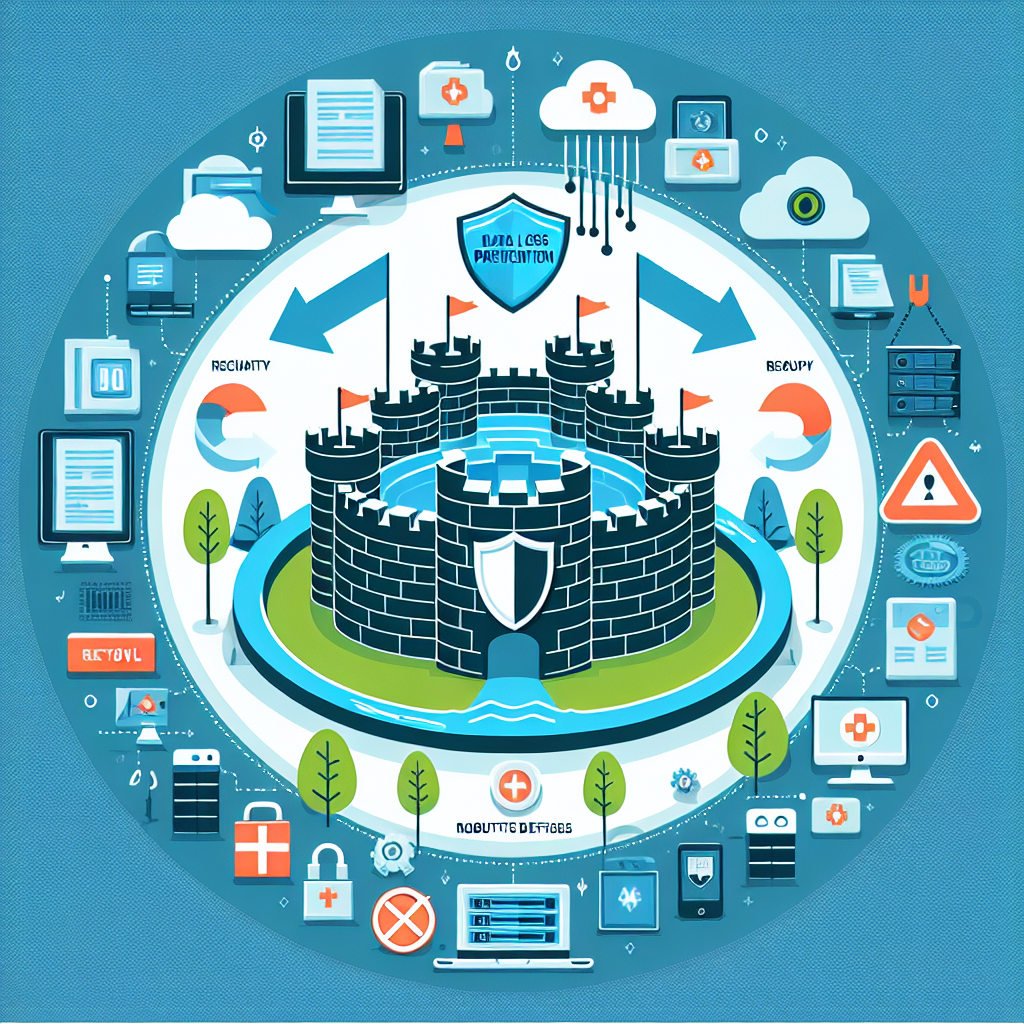Your cart is currently empty!
Tag: Prevention

Data Loss Prevention: Tips for Effective Backup and Recovery
Data loss prevention is a critical aspect of IT security, as losing important data can have serious consequences for businesses. Whether it’s due to hardware failure, human error, or cyber attacks, data loss can disrupt operations and damage a company’s reputation. That’s why having an effective backup and recovery strategy in place is essential to safeguard your data and ensure business continuity.Here are some tips for implementing a robust data loss prevention plan:
1. Regularly Backup Your Data: The first step in data loss prevention is to regularly backup your data. This means making copies of your important files and storing them in a secure location. You can choose to backup your data on external hard drives, cloud storage services, or network-attached storage devices. It’s important to establish a regular backup schedule to ensure that your data is always up-to-date.
2. Use Encryption: Encrypting your backup data adds an extra layer of security, ensuring that even if your backup files are compromised, they are protected from unauthorized access. Make sure to use strong encryption algorithms and secure encryption keys to prevent data breaches.
3. Test Your Backups: Simply having backups in place is not enough. It’s crucial to regularly test your backups to ensure that they are working properly and can be restored in case of a data loss event. Conducting backup and recovery drills can help you identify any issues and make necessary adjustments to your backup strategy.
4. Implement Access Controls: Limiting access to your backup data is essential for data loss prevention. Only authorized personnel should be able to access and manage backup files to prevent unauthorized alterations or deletions. Implementing access controls and user permissions can help protect your backup data from security threats.
5. Monitor Backup Performance: Monitoring the performance of your backup system is crucial for ensuring that your data is properly protected. Keep track of backup completion rates, storage capacity, and any errors or warnings that may indicate potential issues. Regularly review backup logs and reports to identify any anomalies and take corrective actions promptly.
6. Update Your Backup Strategy: As your business grows and evolves, so should your backup strategy. Regularly review and update your backup and recovery plan to accommodate changes in data volume, storage requirements, and technologies. Consider implementing automated backup solutions and disaster recovery plans to streamline the backup process and minimize downtime in case of data loss.
By following these tips for effective backup and recovery, you can better protect your data and minimize the risk of data loss. Data loss prevention is a crucial aspect of IT security, and investing in a robust backup strategy can help safeguard your business against potential threats. Remember that prevention is always better than cure when it comes to data loss, so take proactive steps to protect your data before disaster strikes.

Data Loss Prevention: Tips for Effective Backup and Recovery Practices
Data Loss Prevention: Tips for Effective Backup and Recovery PracticesIn today’s digital age, data is more valuable than ever. From personal photos and documents to sensitive business information, losing data can have serious consequences. That’s why it’s crucial to have a solid data loss prevention strategy in place, including regular backups and effective recovery practices.
Here are some tips to help ensure your data is protected:
1. Implement a regular backup schedule: One of the most important steps in data loss prevention is to regularly back up your data. Whether you choose to back up your data daily, weekly, or monthly, make sure you stick to a consistent schedule. This will ensure that your data is always up-to-date and easily recoverable in case of an emergency.
2. Use multiple backup methods: While traditional methods like external hard drives and USB drives are still popular choices for backing up data, it’s also important to explore alternative options. Cloud storage services, such as Google Drive, Dropbox, and iCloud, offer secure and convenient ways to back up your data. By using multiple backup methods, you can ensure that your data is protected from a variety of threats.
3. Encrypt your backups: To enhance the security of your backups, consider encrypting your data before storing it. Encryption ensures that your data is protected from unauthorized access, making it more difficult for hackers to steal sensitive information. Many backup solutions offer built-in encryption features, so be sure to take advantage of this added layer of security.
4. Test your backups regularly: It’s not enough to simply back up your data – you also need to test your backups regularly to ensure they are working properly. By conducting regular backup tests, you can identify any issues or errors before they become a problem. This will give you peace of mind knowing that your data is safe and easily recoverable.
5. Have a recovery plan in place: In addition to backing up your data, it’s important to have a solid recovery plan in place. This includes knowing how to access and restore your backups in case of a data loss event. Make sure you have clear instructions and procedures in place for recovering your data, and communicate this plan to key stakeholders within your organization.
By following these tips for effective backup and recovery practices, you can significantly reduce the risk of data loss and ensure that your valuable information is protected. Remember, data loss prevention is a proactive process – don’t wait until it’s too late to safeguard your data. Start implementing these best practices today to protect your data and minimize the impact of potential data loss events.

Data Loss Prevention: Strategies for Ensuring Data Backup and Recovery Success
Data loss is a common and devastating problem that many organizations face. Whether it’s due to a natural disaster, human error, or a cyberattack, losing important data can have serious consequences for a business. That’s why having a solid data loss prevention (DLP) strategy in place is crucial for ensuring the success of data backup and recovery efforts.One of the first steps in creating a successful DLP strategy is to identify the types of data that are most critical to your organization. This includes customer information, financial records, intellectual property, and any other data that is essential for the operation of your business. Once you have identified this data, you can then prioritize your backup and recovery efforts to ensure that these critical assets are protected.
Another important aspect of a successful DLP strategy is implementing regular backups of your data. This means creating copies of your data and storing them in a secure location, either on-site or in the cloud. By regularly backing up your data, you can ensure that you have a recent copy available in case of a data loss event.
In addition to regular backups, it’s also important to test your backup and recovery processes regularly. This includes simulating data loss scenarios and practicing the steps needed to recover your data. By testing your backup and recovery processes, you can identify any weaknesses or gaps in your strategy and make necessary adjustments to improve the success of your data recovery efforts.
Another key component of a successful DLP strategy is implementing strong security measures to protect your data from cyber threats. This includes using encryption, access controls, and other security measures to prevent unauthorized access to your data. By implementing strong security measures, you can reduce the risk of data loss due to cyberattacks and ensure the integrity of your data backups.
Finally, it’s important to have a clear and comprehensive data recovery plan in place. This plan should outline the steps that need to be taken in the event of a data loss event, including who is responsible for managing the recovery process, what tools and resources are needed, and how long it will take to recover the data. By having a well-defined data recovery plan, you can ensure a swift and successful recovery of your data in the event of a data loss event.
In conclusion, implementing a successful DLP strategy is essential for ensuring the success of your data backup and recovery efforts. By prioritizing critical data, regularly backing up your data, testing your backup and recovery processes, implementing strong security measures, and having a clear data recovery plan in place, you can greatly reduce the risk of data loss and ensure the integrity of your organization’s data.

The ROI of Proactive Maintenance: How Investing in Prevention Pays Off
Maintenance is a crucial aspect of any business operation, ensuring that equipment and machinery are functioning at optimal levels to keep production running smoothly. While many companies may view maintenance as a reactive measure to address issues as they arise, proactive maintenance strategies can offer significant benefits in terms of cost savings and improved productivity.Proactive maintenance involves taking a preventative approach to equipment upkeep, focusing on regular inspections, routine maintenance tasks, and predictive maintenance techniques to identify and address potential issues before they become major problems. By investing in proactive maintenance, businesses can not only extend the lifespan of their equipment but also minimize downtime, reduce repair costs, and improve overall operational efficiency.
One of the key advantages of proactive maintenance is the potential for a higher return on investment (ROI) compared to reactive maintenance practices. While reactive maintenance may seem like a cost-effective approach in the short term, the long-term costs of unexpected breakdowns, emergency repairs, and lost production time can quickly add up. In contrast, proactive maintenance allows businesses to schedule maintenance tasks at convenient times, avoid costly downtime, and prevent major equipment failures that can lead to expensive repairs or replacements.
In addition to cost savings, proactive maintenance can also lead to increased productivity and efficiency. By keeping equipment in peak condition, businesses can reduce the risk of unexpected breakdowns and delays, allowing for smoother production processes and improved output. Regular maintenance can also help identify and address inefficiencies in equipment performance, optimizing operations and maximizing the productivity of the workforce.
Furthermore, proactive maintenance can enhance safety in the workplace by ensuring that equipment is functioning properly and meeting safety standards. Regular maintenance inspections can identify potential hazards and risks, allowing businesses to address them proactively and reduce the likelihood of accidents or injuries. By prioritizing maintenance and safety, businesses can create a safer work environment for employees and minimize the risk of costly workplace incidents.
Overall, the ROI of proactive maintenance is clear: investing in prevention pays off in terms of cost savings, improved productivity, and enhanced safety. By prioritizing proactive maintenance strategies, businesses can protect their investments, optimize operations, and achieve long-term success in today’s competitive marketplace.

Data Loss Prevention: The Role of Backup and Recovery in IT Security
In today’s digital age, data loss prevention has become a critical concern for businesses of all sizes. With the increasing amount of sensitive information being stored and transferred online, the risk of data breaches and cyber attacks has never been higher. This is where backup and recovery solutions play a crucial role in IT security.Backup and recovery solutions are designed to protect against data loss by creating copies of important information and storing them in a secure location. In the event of a cyber attack, hardware failure, or accidental deletion, these backups can be used to restore lost data and minimize downtime.
One of the key benefits of backup and recovery solutions is that they provide a safety net for businesses in the event of a data breach. By regularly backing up important information, businesses can ensure that even if their systems are compromised, they can quickly recover and restore their data without significant loss. This can help to mitigate the financial and reputational damage that can result from a data breach.
In addition to protecting against data breaches, backup and recovery solutions also play a crucial role in disaster recovery planning. By having a comprehensive backup strategy in place, businesses can ensure that they are able to quickly recover from a wide range of disasters, including natural disasters, power outages, and hardware failures. This can help to minimize downtime and ensure that business operations can quickly resume following a disaster.
It is important for businesses to regularly review and update their backup and recovery strategies to ensure that they are able to effectively protect against data loss. This includes regularly backing up important information, testing backups to ensure they are working correctly, and storing backups in secure and off-site locations to protect against physical threats.
In conclusion, backup and recovery solutions play a crucial role in data loss prevention and IT security. By implementing a comprehensive backup strategy, businesses can protect against data breaches, disaster events, and other threats that can result in data loss. It is essential for businesses to prioritize data protection and invest in robust backup and recovery solutions to safeguard their sensitive information and ensure business continuity.

Data Loss Prevention: Strategies for Effective Backup and Recovery
Data loss can be a catastrophic event for any organization, leading to loss of critical business information, financial repercussions, and damage to reputation. With the increasing amount of data being generated and stored by businesses, it is more important than ever to have effective backup and recovery strategies in place to prevent data loss.Data loss prevention (DLP) is the practice of ensuring that sensitive data is not lost, misused, or accessed by unauthorized users. One of the key components of DLP is having a robust backup and recovery plan in place. This involves regularly backing up data, storing it securely, and being able to quickly recover it in case of a data loss event.
There are several strategies that organizations can implement to ensure effective backup and recovery:
1. Regularly backup data: It is essential to regularly backup all critical data to ensure that in the event of a data loss event, the organization can quickly recover the lost data. This can be done through automated backups that run at regular intervals, ensuring that all data is backed up frequently.
2. Store backups securely: It is important to store backups in a secure location, away from the primary data storage. This can be in a separate physical location, or in the cloud. Storing backups securely ensures that in case of a disaster, the backups are not lost along with the primary data.
3. Test backups regularly: It is crucial to regularly test backups to ensure that they can be successfully recovered in case of a data loss event. This can involve simulating a data loss event and attempting to recover the data from the backups. Testing backups regularly helps identify any issues with the backup process and allows organizations to make necessary adjustments.
4. Implement encryption: Encrypting backups can help ensure that even if the backups are compromised, the data remains secure. Encryption adds an extra layer of security to backups, making it harder for unauthorized users to access the data.
5. Implement a disaster recovery plan: In addition to backups, organizations should have a disaster recovery plan in place. This plan outlines the steps to be taken in case of a data loss event, including who is responsible for managing the recovery process, what resources are needed, and the timeline for recovery.
By implementing these strategies, organizations can ensure effective backup and recovery of critical data, minimizing the risk of data loss and its impact on the business. Data loss prevention is a critical aspect of any organization’s cybersecurity strategy, and having robust backup and recovery strategies in place is essential to protecting sensitive data and ensuring business continuity.

Proactive Maintenance vs. Reactive Maintenance: Why Prevention is Key
Maintenance is an essential aspect of keeping equipment and machinery in optimal working condition. However, there are two main approaches to maintenance: reactive maintenance and proactive maintenance. While both are important, proactive maintenance is often preferred for its numerous benefits over reactive maintenance.Reactive maintenance, also known as run-to-failure maintenance, involves waiting for equipment to break down before taking action. This approach may seem cost-effective in the short term, as it requires minimal planning and investment upfront. However, reactive maintenance can result in costly downtime, emergency repairs, and reduced equipment lifespan. In addition, unexpected breakdowns can disrupt operations and lead to safety hazards for workers.
On the other hand, proactive maintenance, also known as preventive maintenance, involves regularly scheduled inspections, repairs, and replacements to prevent equipment failure before it occurs. By implementing a proactive maintenance program, organizations can reduce the likelihood of unexpected breakdowns, extend the lifespan of equipment, and optimize performance. Proactive maintenance also allows for better planning and budgeting, as maintenance tasks are scheduled in advance.
Prevention is key when it comes to maintenance, and proactive maintenance is the best way to prevent costly breakdowns and repairs. By identifying and addressing potential issues before they escalate, organizations can save time, money, and resources in the long run. In addition, proactive maintenance can improve equipment reliability, reduce downtime, and enhance overall productivity.
In conclusion, proactive maintenance is a proactive approach to equipment maintenance that focuses on prevention rather than reaction. By implementing a proactive maintenance program, organizations can reduce the risk of unexpected breakdowns, improve equipment performance, and save time and money on repairs. Ultimately, prevention is key when it comes to maintenance, and proactive maintenance is the best way to ensure that equipment remains in optimal working condition.

Proactive Maintenance vs Reactive Maintenance: Why Prevention is Key
Maintenance is an essential aspect of keeping equipment, machinery, and infrastructure in good working condition. There are two main approaches to maintenance: proactive maintenance and reactive maintenance. While both are important, proactive maintenance is increasingly being recognized as the superior approach due to its focus on prevention rather than reaction.Reactive maintenance, also known as “run-to-failure” or “breakdown maintenance,” involves waiting for equipment to fail and then fixing it. This approach can be costly and time-consuming, as well as disruptive to operations. It often results in unexpected downtime, lost productivity, and higher repair costs. Additionally, reactive maintenance can lead to safety hazards and environmental damage if equipment fails unexpectedly.
On the other hand, proactive maintenance, also known as preventative maintenance, focuses on preventing equipment failures before they occur. This approach involves regular inspections, testing, and servicing of equipment to identify and address potential issues before they escalate. By taking a proactive approach, maintenance teams can reduce the likelihood of breakdowns, extend the lifespan of equipment, and improve overall reliability and performance.
There are several key reasons why prevention is key when it comes to maintenance. First and foremost, proactive maintenance helps to minimize downtime and disruptions to operations. By addressing potential issues before they cause equipment failures, organizations can avoid costly downtime and maintain productivity levels.
Secondly, proactive maintenance can help to reduce maintenance costs in the long run. By regularly servicing equipment and replacing worn parts, organizations can prevent major breakdowns that require expensive repairs or replacements. This can result in significant cost savings over time.
Additionally, proactive maintenance can improve safety and compliance. By ensuring that equipment is well-maintained and in good working condition, organizations can reduce the risk of accidents, injuries, and environmental incidents. This not only protects employees and assets but also helps organizations meet regulatory requirements and industry standards.
In conclusion, while both proactive and reactive maintenance are important, prevention is key when it comes to maintaining equipment and infrastructure. By taking a proactive approach to maintenance, organizations can minimize downtime, reduce costs, improve safety, and enhance overall performance. Investing in proactive maintenance strategies can ultimately lead to a more efficient, reliable, and sustainable operation.

The Benefits of Proactive Maintenance: Why Prevention is Key
When it comes to maintaining equipment and machinery, many companies adopt a reactive approach, waiting for something to go wrong before taking action. However, proactive maintenance, which focuses on preventing issues before they occur, is becoming increasingly popular for good reason. In this article, we will explore the benefits of proactive maintenance and why prevention is key for businesses of all sizes.One of the main benefits of proactive maintenance is that it can help prevent costly downtime. By regularly inspecting and maintaining equipment, businesses can identify and address potential issues before they escalate into major problems that require extensive repairs or replacements. This can help minimize downtime and ensure that operations run smoothly, ultimately saving the company time and money.
Proactive maintenance also allows businesses to extend the lifespan of their equipment. By regularly servicing and maintaining machinery, companies can ensure that it continues to operate efficiently and effectively for longer periods of time. This can help businesses maximize their return on investment and avoid the need for costly replacements in the future.
In addition, proactive maintenance can improve workplace safety. By identifying and addressing potential safety hazards before they cause accidents or injuries, businesses can create a safer work environment for their employees. This not only protects the well-being of workers but also helps businesses avoid costly lawsuits and fines associated with workplace accidents.
Furthermore, proactive maintenance can help businesses improve their overall efficiency and productivity. By keeping equipment in optimal condition, companies can reduce the risk of breakdowns and disruptions that can derail operations. This allows employees to focus on their tasks without worrying about equipment failures, leading to increased productivity and profitability.
Overall, proactive maintenance is a valuable strategy for businesses looking to optimize their operations and minimize risks. By taking a preventive approach to maintenance, companies can save time and money, extend the lifespan of their equipment, improve workplace safety, and enhance efficiency and productivity. In today’s competitive business environment, prevention is key, and proactive maintenance is a vital tool for success.

Data Loss Prevention: Why Data Backup and Recovery is Crucial for Businesses
Data loss prevention is a critical aspect of business operations that cannot be overlooked. In today’s digital age, businesses rely heavily on their data to operate efficiently and effectively. From customer information to financial records, data is the lifeblood of any organization. That is why data backup and recovery is crucial for businesses to ensure the safety and security of their valuable information.Data loss can occur due to a variety of reasons, including hardware failure, human error, malware attacks, and natural disasters. Without proper backup and recovery measures in place, businesses risk losing important data that could have a significant impact on their operations. This could result in financial losses, damage to reputation, and even legal consequences.
By implementing a data backup and recovery plan, businesses can protect themselves from the devastating effects of data loss. Backup solutions allow businesses to create copies of their data and store them in secure locations, such as cloud servers or external hard drives. This ensures that even if the original data is lost or corrupted, there is a backup copy available for retrieval.
In addition to backup solutions, businesses should also have a robust data recovery plan in place. This involves having the necessary tools and procedures in place to quickly and efficiently recover lost or corrupted data. By having a well-defined data recovery plan, businesses can minimize downtime and resume normal operations as soon as possible after a data loss incident.
Data backup and recovery is not just important for protecting against data loss, but it is also essential for compliance with data protection regulations. Many industries are subject to strict data protection laws that require businesses to safeguard their data and ensure its confidentiality, integrity, and availability. Failure to comply with these regulations can result in hefty fines and legal consequences.
Overall, data loss prevention is a crucial aspect of business operations that cannot be ignored. By implementing a comprehensive data backup and recovery plan, businesses can protect their valuable information, minimize the risk of data loss, and ensure compliance with data protection regulations. Investing in data backup and recovery solutions is a small price to pay for the peace of mind and security it provides to businesses in today’s digital age.
